Livorno Sights – Attrazioni di Livorno
- Maria Scuor
- Jan 4
- 9 min read
Updated: Jan 5
Italiano sotto ogni sezione
Here is a TikTok video of the Livorno sights we saw - Ecco un video TikTok delle attrazioni di Livorno che abbiamo visto
OK today I was stupefied when I found out that the English word for Livorno, the port city on the Ligurian Sea in the Tuscany region in Italy is “LEGHORN”. I will continue to use Livorno in my blog as I’m sure most people will know it as that. Livorno is the capital of the Province of Livorno and has a population of about 153,000.
There is controversy over Livorno’s origins but there are pieces of copper and ceramic found in the hills that date back to the Stone Age. However, the first time Livorno is mentioned is in 1017 as a small coastal village and the port was under rule of Lucca. By 1103, the Republic of Pisa owned and built the Quadrature dei Pisani (Quarter of the Pisans) fort to defend the port. The fort was destroyed in the Battle of Meloria in 1284.
Livorno was sold to the Visconti of Milan in 1399 which in turn sold it to the Republic of Genoa in 1405. On August 28, 1421 it was bought by the Republic of Florence under the name Ligorna and the name Livorno was using in the 18th century by the Florentines. Interesting in between 1427 and 1429 there were 118 families for a total of 423 people living in the area.
By 1562 the population had grown to 1562 when the Medici ruling dynasty of Florence built the Fortezza Vecchia (Old Fortress) which stimulated voluntary settlement. It also became a major Mediterranean slave trade hub with slaves being 25% of the population. The Medici also wanted to design the city to be an “Ideal town” where the noble families would build their homes.
In 1576, architect Bernardo Buontalenti drew up the first plan of the new fortified town and had a pentagonal design. The Fortezza Nuove was completed in 1607 but in the meantime, Livorno was declared a free port in 1580, which meant the goods traded there were duty-free within the area of the town’s control. The Livornine Laws were established in 1593, that regulated trade and protected the merchant activities from crime and racketeering.
By the late 16th century, Livorno attracted Turks, Persians, Moors, Greeks, Armenians and Jewish immigrant. Livorno extended rights to them and they continued to contribute to the mercantile wealth and scholarship in the city. This made Livorno one of the most important ports of the entire Mediterranean Basin which led to many European foreigners to move to Livorno. On March 19th 1606, Ferdinando I de’Medici elevated Livorno to the rank of city.
By 1745 Livorno’s population had risen to over 32,000 and the European powers established trading houses in the region, especially the British with the Levant Company. This brought an increase in British writers, artists, philosophers, and travelers which developed the unique historical ties between the two communities. The British referred to the city in English as "Leghorn", derived from the Genoese term. Through the years the city’s trade fortunes rose and fell according to the success or failure of the Great Powers.
In 1861, Livorno and Tuscany became part of the new Kingdom of Italy and lost its status of a free port which caused the city’s commercial industry to decline. During the 1930s there were many villas built along the sea which added beauty and architectural richness to the city. However, like most cities in Italy, it suffered extensive damage during World War II and buildings like the cathedral and Synagogue were destroyed.
The city and its port have continued to be an important travel destination for tourists. Thousands of passengers come through on 15 different cruise-ships lines every year to visit the incredible historical buildings, Mascagni Terrace and the many churches including the amazing Sanctuary of Montenero at the hilltop overlooking Livorno. Of course, there is delicious food to be had all over the city. We had breakfast at Cairoli Bakery both days we were there as the choices were out of this world. They also make large cappuccinos which were delicious.
Here are photos of Cairoli Bakery and the food we had at 10+10 Restaurant & Pizzeria - Ecco le foto della Pasticceria Cairoli e del cibo che abbiamo mangiato al Ristorante & Pizzeria 10+10
OK oggi sono rimasto stupefatta quando ho scoperto che la parola inglese per Livorno, la città portuale sul Mar Ligure nella regione Toscana in Italia, è "LEGHORN". Continuerò ad usare Livorno nel mio blog perché sono sicuro che la maggior parte delle persone lo conoscerà così. Livorno è il capoluogo della Provincia di Livorno e conta una popolazione di circa 153.000 abitanti.
C'è polemica sulle origini di Livorno ma ci sono pezzi di rame e ceramica ritrovati sulle colline che risalgono all'età della pietra. Tuttavia, la prima volta che Livorno viene citata è nel 1017 come un piccolo villaggio costiero e il porto era sotto il dominio di Lucca. Nel 1103 la Repubblica di Pisa possedeva e costruiva la Quadratura dei Pisani per difendere il porto. Il forte fu distrutto nella battaglia della Meloria nel 1284.
Livorno fu venduta ai Visconti di Milano nel 1399 che a loro volta la vendettero alla Repubblica di Genova nel 1405. Il 28 agosto 1421 fu acquistata dalla Repubblica di Firenze con il nome di Ligorna e il nome Livorno fu usato nel XVIII secolo dai fiorentini. Interessante è che tra il 1427 e il 1429 vi erano 118 famiglie per un totale di 423 persone che vivevano nella zona.
Nel 1562 la popolazione era cresciuta fino al 1562, quando la dinastia regnante dei Medici di Firenze costruì la Fortezza Vecchia, che stimolò l'insediamento volontario. Divenne anche un importante centro del commercio di schiavi nel Mediterraneo, con schiavi che rappresentavano il 25% della popolazione. I Medici vollero anche progettare la città come una "città ideale" dove le famiglie nobili avrebbero costruito le loro dimore.
Nel 1576 l'architetto Bernardo Buontalenti elaborò il primo progetto della nuova città fortificata e fece avere una pianta pentagonale. La Fortezza Nuove fu completata nel 1607 ma nel frattempo Livorno fu dichiarata porto franco nel 1580, il che significava che le merci ivi scambiate erano esenti da dazi all'interno dell'area di controllo della città. Nel 1593 furono istituite le Leggi Livornine, che regolavano il commercio e proteggevano le attività mercantili dalla criminalità.
Alla fine del XVI secolo, Livorno attrasse turchi, persiani, mori, greci, armeni e immigrati ebrei. Livorno estese loro i diritti e continuarono a contribuire alla ricchezza mercantile e all'erudizione della città. Questo ha reso Livorno uno dei porti più importanti dell'intero bacino del Mediterraneo, il che ha portato molti stranieri europei a trasferirsi a Livorno. Il 19 marzo 1606 Ferdinando I de' Medici elevò Livorno al rango di città.
Nel 1745 la popolazione di Livorno era salita a oltre 32.000 abitanti e le potenze europee stabilirono case commerciali nella regione, in particolare gli inglesi con la Compagnia del Levante. Ciò portò un aumento di scrittori, artisti, filosofi e viaggiatori britannici che svilupparono i legami storici unici tra le due comunità. Gli inglesi si riferivano alla città in inglese come "Leghorn", derivato dal termine genovese. Nel corso degli anni le fortune commerciali della città aumentarono e diminuirono a seconda del successo o del fallimento delle grandi potenze.
Nel 1861 Livorno e la Toscana entrarono a far parte del nuovo Regno d'Italia e persero il loro status di porto franco che causò il declino dell'industria commerciale della città. Durante gli anni '30 c'erano molte ville costruite lungo il mare che aggiungevano bellezza e ricchezza architettonica alla città. Tuttavia, come la maggior parte delle città italiane, subì ingenti danni durante la seconda guerra mondiale ed edifici come la cattedrale e la sinagoga furono distrutti.
La città e il suo porto hanno continuato ad essere un'importante destinazione di viaggio per i turisti. Migliaia di passeggeri transitano ogni anno su 15 diverse linee di navi da crociera per visitare gli incredibili palazzi storici, la Terrazza Mascagni e le numerose chiese tra cui lo splendido Santuario di Montenero in cima alla collina che domina Livorno. Naturalmente, c'è del cibo delizioso in tutta la città. Abbiamo fatto colazione al Cairoli Bakery entrambi i giorni in cui eravamo lì perché le scelte erano fuori dal mondo. Fanno anche grandi cappuccini che erano deliziosi. Qui sopra ci sono le foto della Pasticceria Cairoli e del cibo che abbiamo mangiato al Ristorante & Pizzeria 10+10
Market – Mercato
The Mercato delle Vettovaglie or also known as Mercato Centrale (central) or Mecato Coperto (covered) was designed by Italian architect and engineer Angiolo Badaloni based on the traditional central markets of Paris, Les Halles. It was inaugurated in 1894 and is one of the largest covered markets in Italy.
It was not only the hub devoted to food trade, but on the second floor there were offices housing painters and sculptors of the 20th century which became part of the art and culture of Livorno. Just like most buildings during World War II, the market was heavily damaged. But the local administration and citizens of Livorno quickly brought the building to its original splendor. The inside market has about 200 booths selling everything edible with a few home supply shops. Outside there are probably just as many booths selling everything and anything. It truly is a place to visit when in Livorno.
Here are photos of the covered and uncovered markets - Ecco le foto dei mercati coperto e scoperto
Covered market - Mercato Coperto
Uncovered market - Mercato scoperto
Il Mercato delle Vettovaglie o anche Mercato Centrale o Mecato Coperto è stato progettato dall'architetto e ingegnere italiano Angiolo Badaloni sulla base dei tradizionali mercati centrali di Parigi, Les Halles. Inaugurato nel 1894, è uno dei più grandi mercati coperti d'Italia.
Non era solo il fulcro dedicato al commercio alimentare, ma al secondo piano c'erano gli uffici che ospitavano pittori e scultori del XX secolo che entrarono a far parte dell'arte e della cultura di Livorno. Proprio come la maggior parte degli edifici durante la seconda guerra mondiale, il mercato è stato pesantemente danneggiato. Ma l'amministrazione locale e i cittadini di Livorno riportarono rapidamente l'edificio al suo originario splendore. Il mercato interno ha circa 200 bancarelle che vendono tutto ciò che è commestibile con alcuni negozi di articoli per la casa. All'esterno ci sono probabilmente altrettante bancarelle che vendono di tutto e di più. È davvero un posto da visitare quando si è a Livorno.
Republic Square - Piazza della Republica
There was a need to connect the new eastern districts of the town to the other side of the Fosso Reale (a moat of the fortified city). This meant it was required to remove the city gate Porta a Pisa. Around 1844, Italian architect Luigi Bettarini proposed the solution of covering the moat with a large vault measuring 240 m (788 ft) long and 90 m (296 ft) wide. The portion of the canal, covered by the new structure would be and is navigable.
At the street level the large square with an oval-shaped platform is surrounded by street lamps, marble benches and small columns that used to be used to rest horses. On the south side of the square is the statue dedicated to Grand Duke Ferdinand III which was inaugurated in 1847. At the opposite north side of the square is the stature dedicated to Grand Duke Leopold II which was inaugurated in 1855.
The square has had several names:
Piazza del Voltone or Vault Square from 1844 until 1850
Piazza del Granduchi or Square of the Grand Dukes until 1859
Piazza Carlo Alberto or Carlo Alberto Square from 1859 until 1946, in honour of the leader of the first War of Independence
And finally, Piazza della Repubblica or Republic Square since June 1946
Here are photos of the piazza – Ecco le foto della piazza
Piazza della Republica
C'era la necessità di collegare i nuovi quartieri orientali della città all'altra sponda del Fosso Reale. Ciò ha comportato la necessità di rimuovere la porta della città Porta a Pisa. Intorno al 1844, l'architetto italiano Luigi Bettarini propose la soluzione di coprire il fossato con una grande volta lunga 240 m e larga 90 m. La porzione di canale, coperta dalla nuova struttura sarebbe ed è navigabile.
Al livello della strada la grande piazza con una piattaforma di forma ovale è circondata da lampioni, panchine in marmo e colonnine che un tempo servivano per far riposare i cavalli. Sul lato sud della piazza si trova la statua dedicata al Granduca Ferdinando III che fu inaugurata nel 1847. Sul lato nord opposto della piazza si trova la statua dedicata al Granduca Leopoldo II, inaugurata nel 1855.
La piazza ha avuto diversi nomi:
Piazza del Voltone dal 1844 al 1850
Piazza del Granduchi fino al 1859
Piazza Carlo Alberto dal 1859 al 1946, in onore del condottiero della Guerra d'Indipendenza
E infine, Piazza della Repubblica dal giugno 1946
Medici Canals - Canali Medicei
Since the construction of the New Fortress in 1576 with the canal system that was put in place around the island, trade would come from the port throughout the city of Livorno. Today you can take a 45-minute boat tour that travels through the historical districts of Pontino, Venezia and Ovo Sodo.
Here you will see the fortresses, merchant docks of yesteryear, historic fishermen's cellars that preserve the maritime tradition of the past, pass under the widest bridge in Europe under Piazza della Repubblica, admire the architecture splendor of Mercato Centrale and be in awe of the 19th century monumental palaces of the rich Livorno families.
Here are photos of the canals - Ecco le foto dei canali
Canali Medicei
Dalla costruzione della Fortezza Nuova nel 1576 con il sistema di canali che fu messo in atto intorno all'isola, il commercio sarebbe arrivato dal porto in tutta la città di Livorno. Oggi è possibile fare un tour in barca di 45 minuti che attraversa i quartieri storici di Pontino, Venezia e Ovo Sodo.
Qui vedrete le fortezze, i porti mercantili di un tempo, le storiche cantine dei pescatori che conservano la tradizione marinara di un tempo, passerete sotto il ponte più largo d'Europa sotto Piazza della Repubblica, ammirerete lo splendore architettonico del Mercato Centrale e rimarrete a bocca aperta di fronte ai palazzi monumentali ottocenteschi delle ricche famiglie livornesi.
Here are photos of other sights we saw on our adventure in the center of Livorno - Ecco le foto di altri luoghi che abbiamo visto durante la nostra avventura nel centro di Livorno
Synagogue - Sinagoga
Statues - Statue
Buildings - Edifici





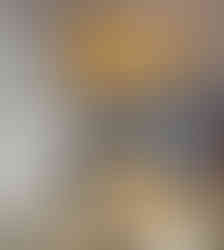






















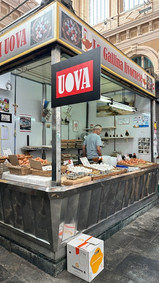







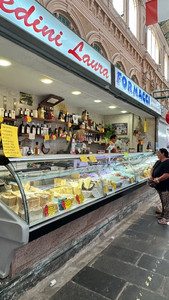























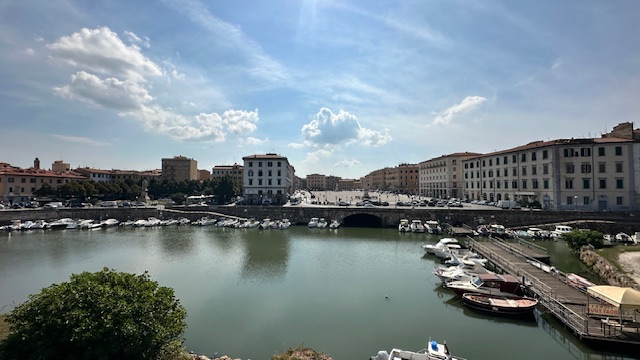





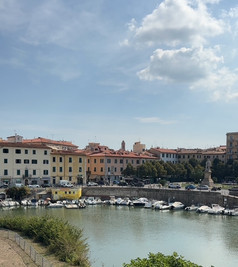







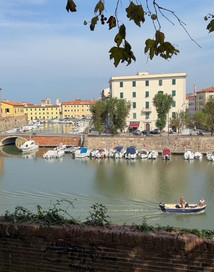









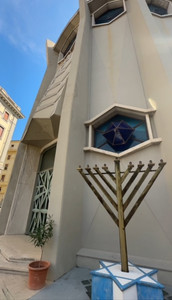









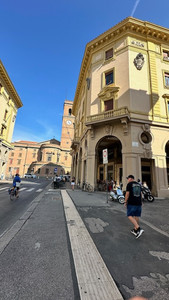





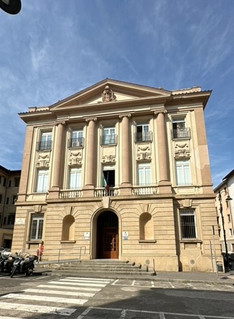









Comentarios